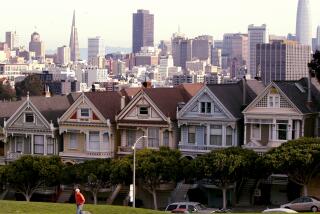Washington rethinks its limits on building heights
- Share via
Moeller doesn’t expect the height limits to be repealed “because people around the world would protest, just as they would if someone came up and said, ‘I want to build a skyscraper along the Champs-Elysees.’”
WASHINGTON — It blocked views. It shut out sunlight. The “great size” of the 12-story Cairo apartment building so angered the people of Washington, D.C., back in the 1890s that Congress eventually enacted a law that dramatically shaped the landscape of the nation’s capital.
Thanks to the controversial Cairo, building heights in Washington have been restricted for more than a century to prevent high-rises from obstructing views of the Capitol, the Washington Monument and other majestic landmarks.
But in 2012, the District of Columbia has a new priority: finding ways to increase its tax base. As a result, officials are launching a study on whether to relax the federal Height of Buildings Act of 1910, enacted when William Howard Taft occupied the White House and the city’s population was about half of what it is today.
“This has helped shape our capital city, but as some have argued, may have also stunted its potential,” Rep. Trey Gowdy (R-S.C.) said at a congressional hearing on the height limit.
Buildings on commercial streets are limited to 130 feet, typically 10 to 13 stories, except for a stretch of Pennsylvania Avenue where they can reach up to 160 feet.
Across the Potomac River, buildings in Virginia soar more than 300 feet, with new ones approved or under construction rising higher, up to 30 stories.
“Some people say, ‘See, we’ve got moderately tall buildings over there, and they don’t mess things up,’” said Washington architectural curator G. Martin Moeller Jr., “and others say, ‘Yes, they do. They’re a terrible blight on the views from the city.’”
A popular myth is that the law prohibits any building from being taller than the 555-foot Washington Monument, the city’s tallest structure, or the 287-foot Capitol. In reality, maximum building heights are tied to the width of adjacent streets.
“Part of the love affair with the unique character of Washington has to do with the fact that monuments, particularly the Washington Monument and the Capitol, are visible from so many places,” said Roger Lewis, professor emeritus at the University of Maryland School of Architecture, Planning and Preservation.
D.C. officials want to look at whether taller buildings — not skyscrapers, they insist — could be constructed farther away from the city’s monumental core, perhaps across the Anacostia River in the southeastern part of the city.
The business community believes that current rules serve areas like Pennsylvania Avenue and the major part of the central business district well, but that “there are parts of the city where views and aesthetics would not be impaired by buildings of increased height,” said Barbara Lang, president and chief executive of the D.C. Chamber of Commerce. “Relaxing the height restrictions in these areas would provide developers more flexibility, and ultimately increase the tax revenue that flows to the city.”
Pedro Ribeiro, a spokesman for Washington Mayor Vincent C. Gray, assured, “You’re not going to have a building that’s going to overshadow the Washington Monument.”
Some say that the height limit has led to flat, uninspiring architecture, and that relaxing the rules would open opportunities to build more affordable housing.
The study, expected to take a year, grows out of the earlier hearing earlier when several members of Congress “opined during the hearing that there’s nothing magic about 130 feet,” said Washington Planning Director Harriet Tregoning.
Any changes must be approved by Congress.
“We haven’t looked at this matter in more than 100 years,” Tregoning said.
But like the still-towering Cairo, many residents see no upside to taller buildings.
“I’ve had visitors from all over the world, and nobody has ever said to me, ‘Where are the tall buildings?”’ said George Clark, chairman of the Committee of 100 on the Federal City, a group dedicated to preserving Washington’s historic distinction.
Those who want to preserve the height limits reject suggestions that taller buildings farther from the monumental core would have no impact.
“The monumental core derives its impact from its dominance,” said Laura M. Richards, representing Committee of 100.
Moeller doesn’t expect the height limits to be repealed “because people around the world would protest, just as they would if someone came up and said, ‘I want to build a skyscraper along the Champs-Elysees.’”
If the height limit is relaxed, said Janet Quigley, president of the Capitol Hill Restoration Society, it would diminish the grandeur of the public buildings and monuments that “stir feelings of national pride and draw hundreds of thousands of visitors to the district each year.”
“A unique nation deserves a unique and special capital city,” she wrote lawmakers. “We have such a city today, and the Height Act has played a strong and constructive role in making it so.”
More to Read
Sign up for Essential California
The most important California stories and recommendations in your inbox every morning.
You may occasionally receive promotional content from the Los Angeles Times.














